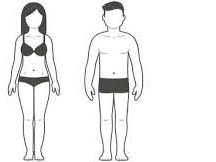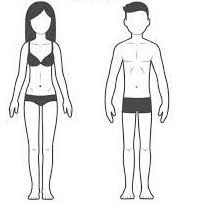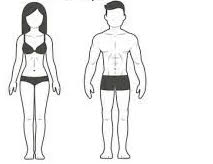The three body types,
explained
Learn your somatotypes to better understand your weight loss potential.
Ectomorph Mesomorph Endomorph
Most of us can slot our overall build into one of three general categories (recognizing that there are a wide variety of shapes and sizes even within these categories).
Body composition is liberating because it gives you something to focus on (in a good way): lean body mass. No matter what the scale says, if you’re in a healthy body-composition range, you’re doing well! Your ideal body composition depends on your goals. If you’re a competitive athlete, your aim is likely the lower end of the body-fat percentage scale (again, taking your somatotype into consideration), but remember that you are never gunning for zero fat, and lower is not always better.
Related: 4 Strength Training Hacks for Women
Women naturally have more fat than men, as we have a greater amount of essential fat (fat needed for bodily functions, from forming reproductive tissue to aiding the absorption of vitamins consumed in different foods). The body-fat ranges for optimal health are 14 to 30 percent for women and 6 to 25 percent for men. Don’t get too hung up on trimming every little ounce, however. If you’re at the lower end of the body-fat spectrum but are generally fit or athletic, you’re not going to gain performance benefits by focusing on fat loss. And you might just make yourself sick.
So first, start by identifying your body type. Here’s how to begin:
Ectomorph
You tend to be long limbed and not particularly muscular. You can be “skinny fat,” meaning you’re a relatively low weight and/or small size, yet still have high body fat.
Ectomorphs are the body type that is the most resistant to weight gain because of a fast metabolism. In other words, ectomorphs are often able to overeat while gaining little or even no weight. People with this body type have little observable body fat, are only lightly muscled, and have a small frame and joints. Basically your genetic makeup limits your ability to put on muscle mass. When training, focus on power and resistance training to build strength.
To maximize body composition (lean-mass gain, body-fat loss) as an ectomorph, eat good-quality fats with moderate protein intake of 25 to 30 grams per meal (four meals per day if you have a pre-training mini-meal) along with good-quality carbohydrates. On non-training/exercising days, skip the pre-training and morning snack: Breakfast is hearty enough to carry you through to lunch. If you have afternoon snacks, you may want to make your dinner intake a bit lighter.
Mesomorph
You find it super easy to build muscle mass, and you are generally proportionally built.
Mesomorphs can lose and gain weight easily, are able to build muscle quickly, and usually boast an upright posture. This body type tends to have a long torso and short limbs. Women with a mesomorph body type are strong and athletic. Mesomorphs excel in explosive sports—that is, sports calling for power and speed. The reason for this talent lies in the type of muscle mesomorphs possess. Mesomorphs have a higher percentage of fast-twitch fibers and will gain muscle mass more quickly than any other body type. Basically your genetic makeup suits power and strength. For training, focus on moderate endurance training, high-intensity interval training (HIIT), and plyometrics. You can add in Pilates or yoga to lengthen with strength.
To maximize body composition (lean-mass gain, body-fat loss) as a mesomorph, eat good-quality fats with moderate carbohydrates and consider timing your protein and branched-chain amino acid (BCAA) intake. On non-training/exercising days, skip the pre-training snack and just have green tea or coffee in the afternoon. Eat your usual pre-dinner and evening snacks.

Endomorph
You are generally softer and rounder and tend to store fat easily.
Endomorphs are the body types that are most likely to feel like they drew the short straw. Endomorphs naturally tend to have curvy, fuller figures and struggle to keep their body-fat percentage in check. The most difficult challenge for endomorphs is perhaps to find out that they are in fact an endomorph. Why? Once you know you are an endomorph, it can be difficult to come to terms with the realization that you are likely to gain weight very easily.
You have the type of metabolism that is not forgiving. However, this doesn’t mean you are destined to be overweight or even obese. As an endomorph, you have to make a conscious, concerted effort to do the things your body should be doing for you automatically. If your body isn’t instinctively telling you to move more, you have to make sure that exercise, such as running, is part of your daily routine.
If your metabolism is sluggish, you need to eat the right foods that will fire up your metabolism. Training-wise, high-intensity activities such as HIIT and CrossFit are great, as are weight training and moderate endurance training. As an endomorph, eat good-quality fats and protein and limit your carbohydrate intake to maximize body composition (lean-mass gain, body-fat loss) and to control insulin and blood sugar. On non-training/exercising days, have breakfast within 45 minutes of waking up and skip the pre- and post-training snacks. Be sure to temper your afternoon snack to your appetite.
The article The 3 Body Types, Explained originally appeared in Rodale Wellness. Adapted from Roar.
This high-intensity strength routine boosts metabolism and builds total-body fitness.
MORE ARTICLES
Are You Wearing the Right Shoes?
If there is anything that’s worth bringing to your attention…
The Importance of Fluid Balance and Hydration
Water performs several important functions in the body…




